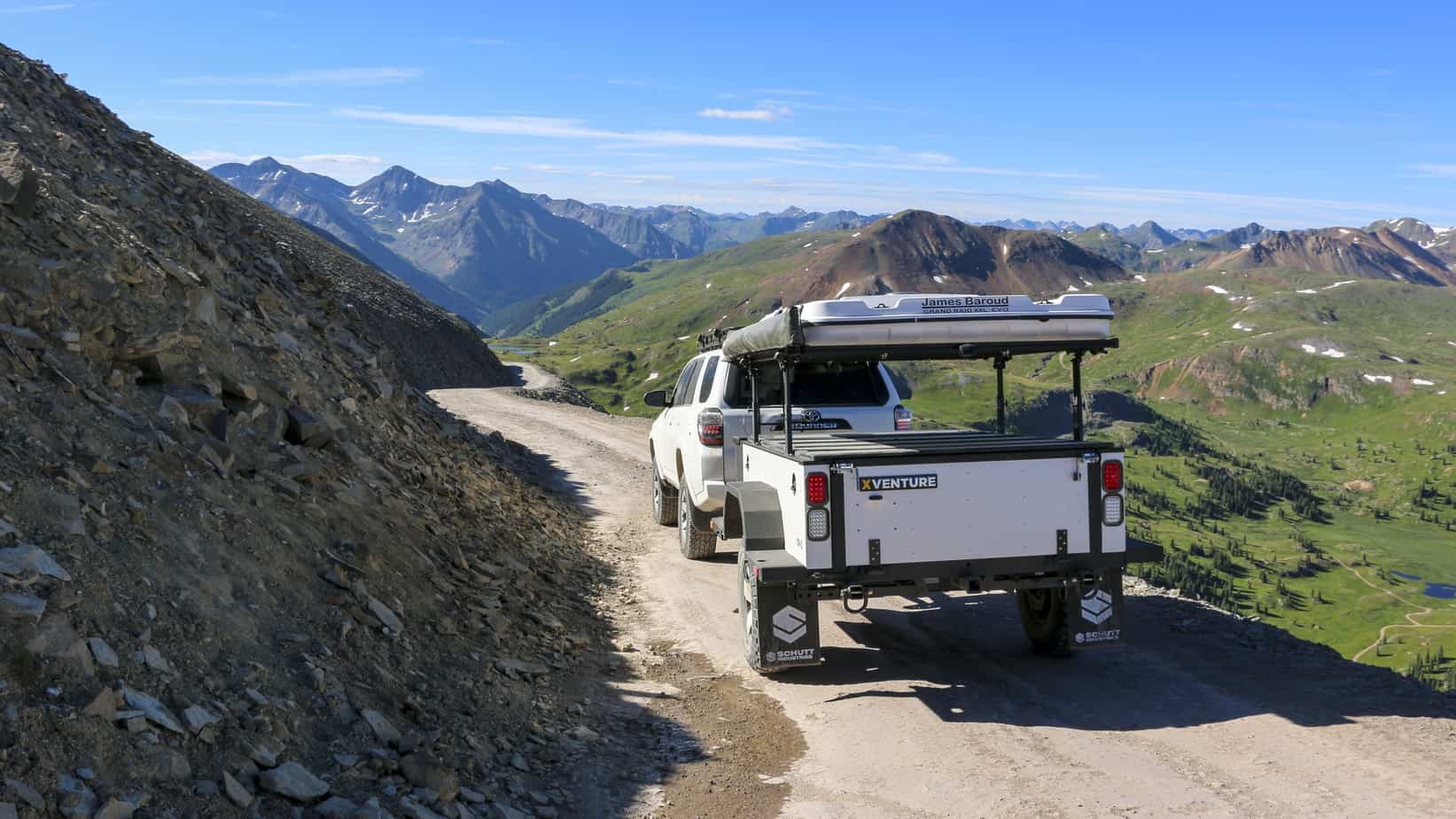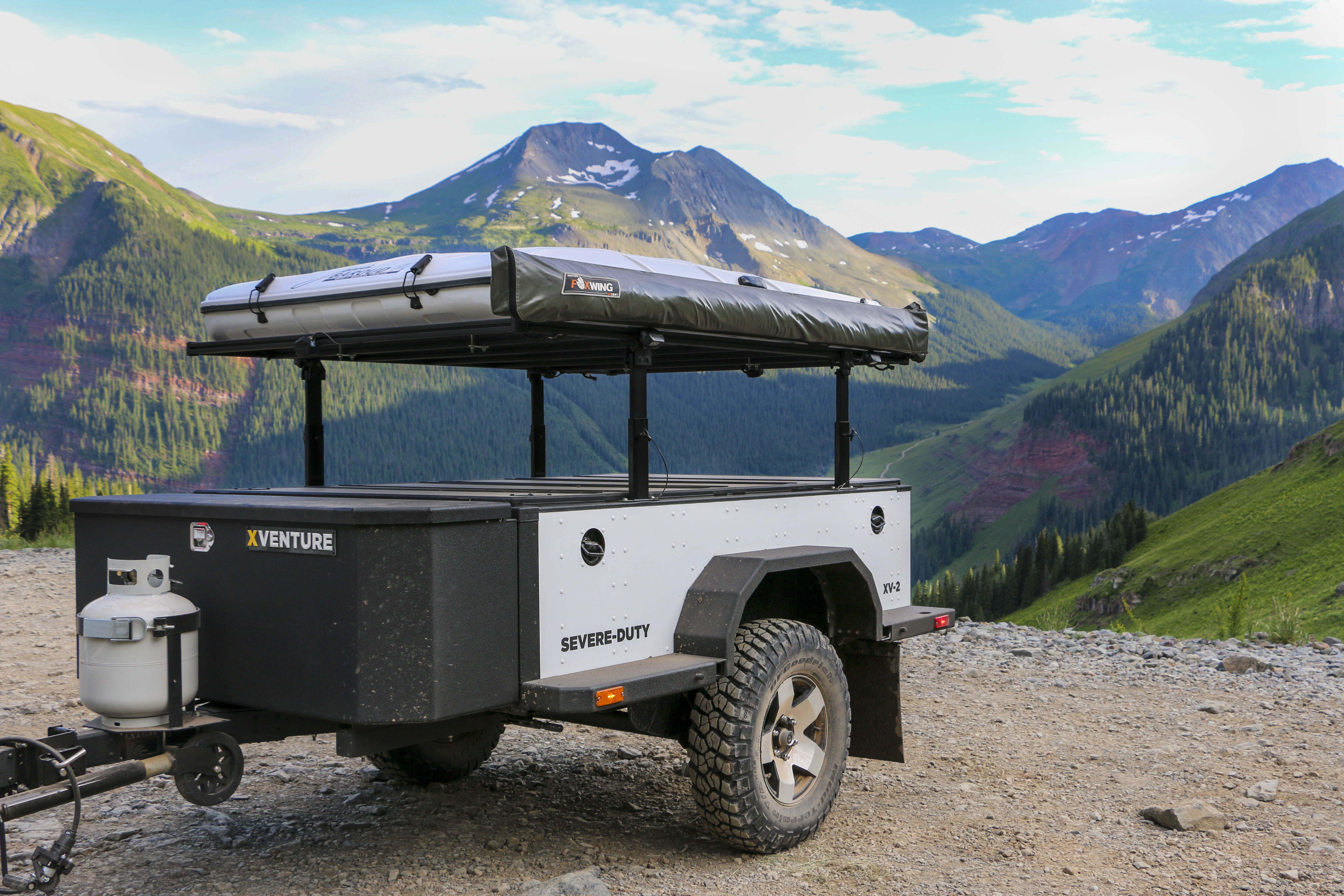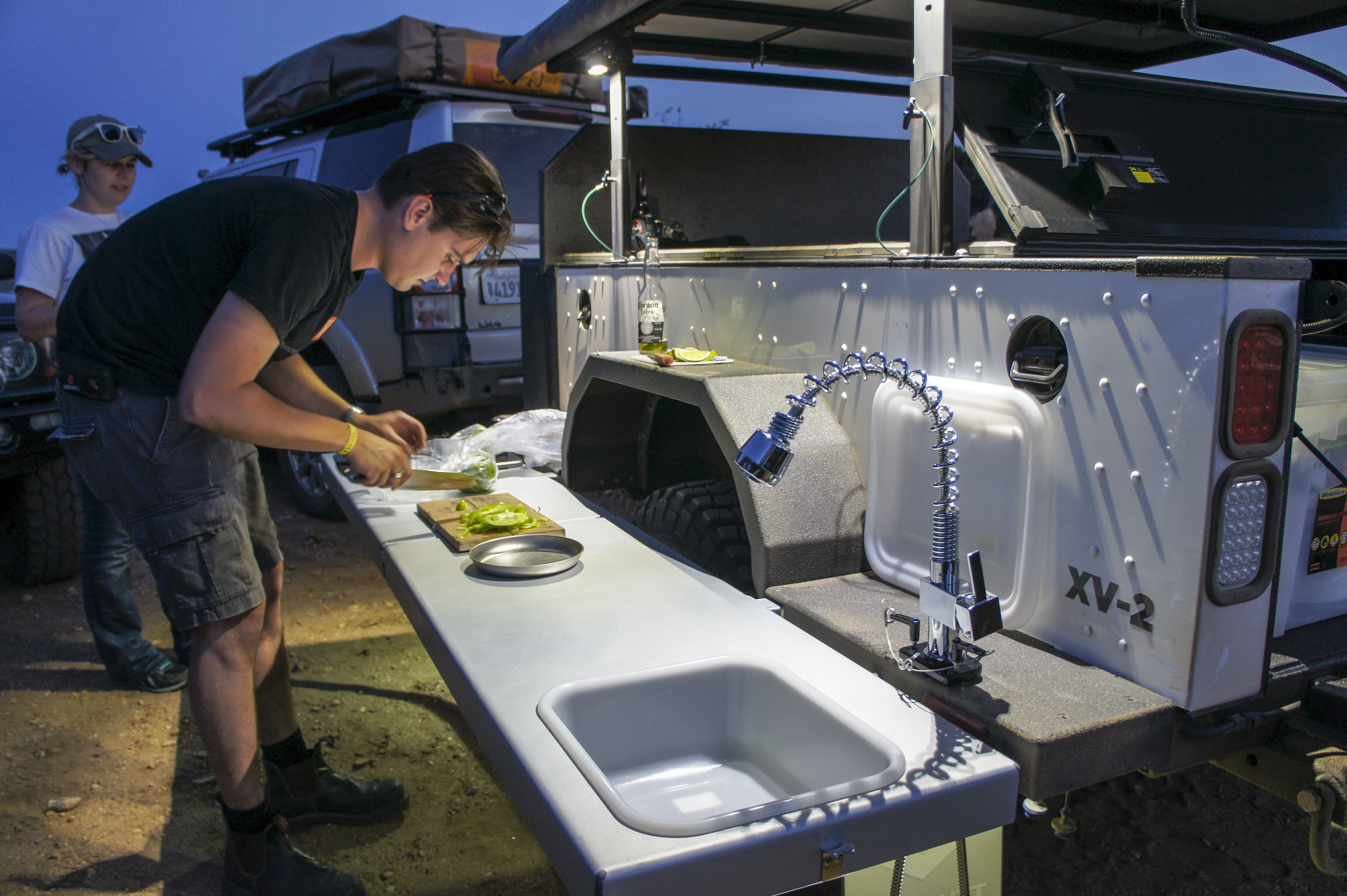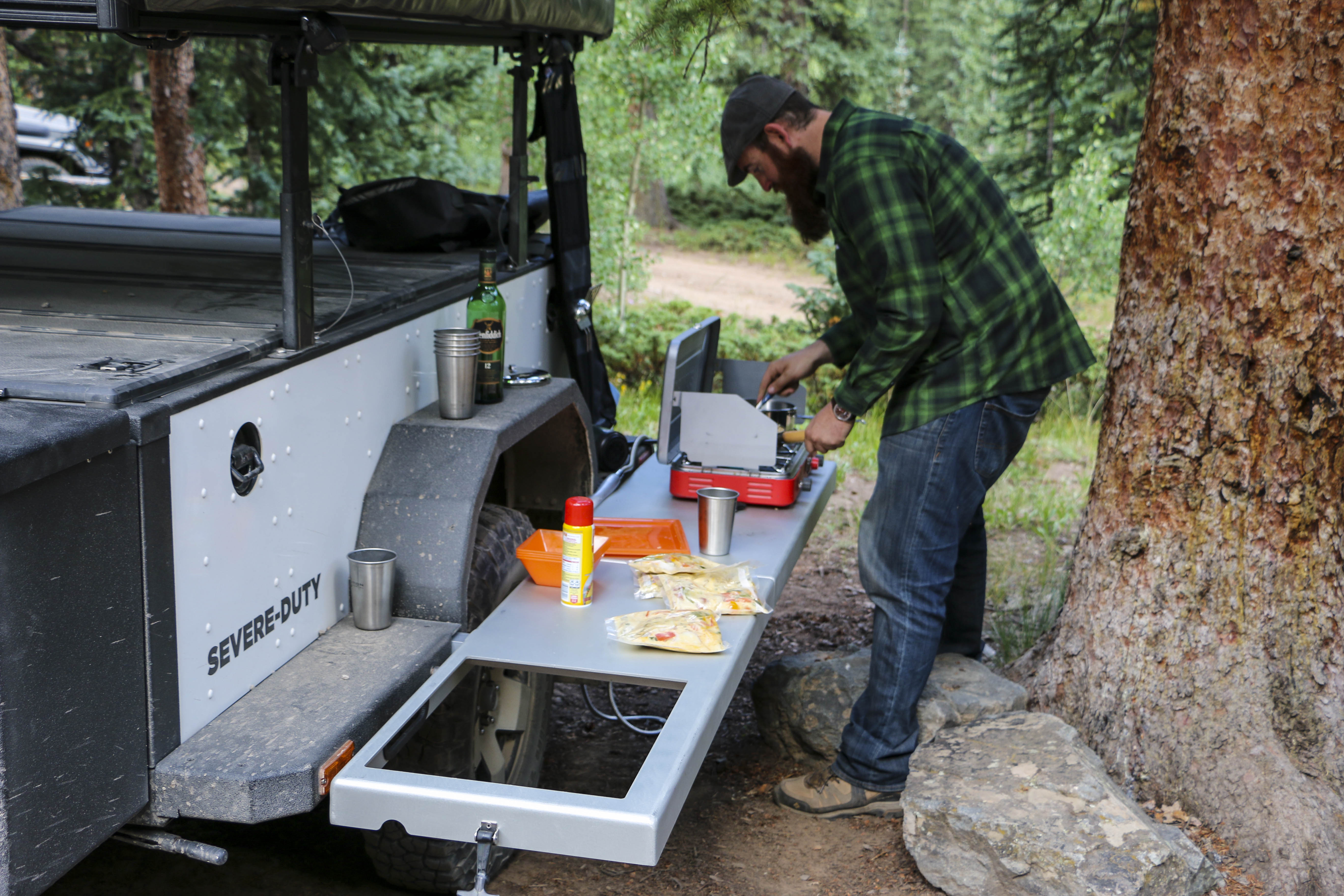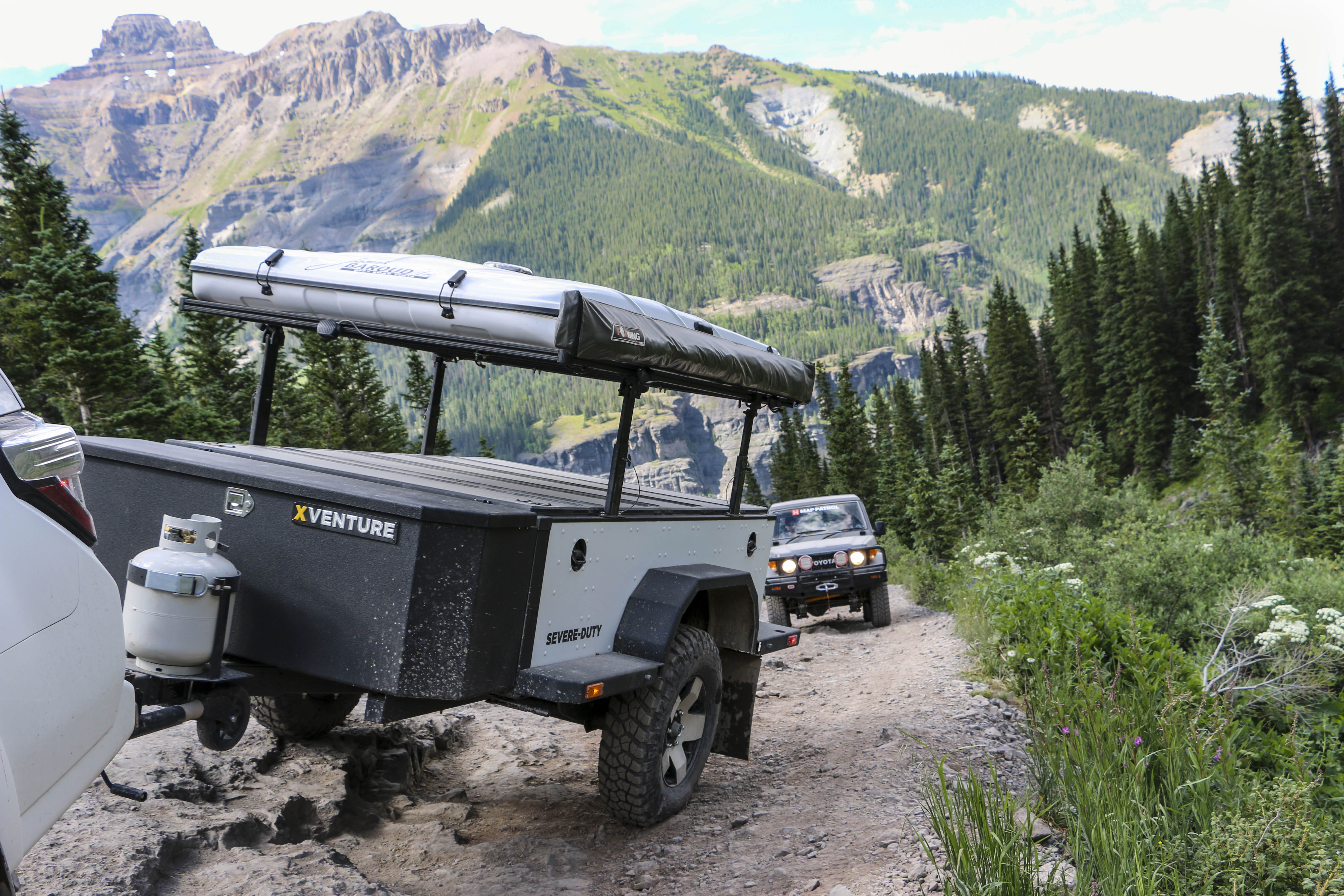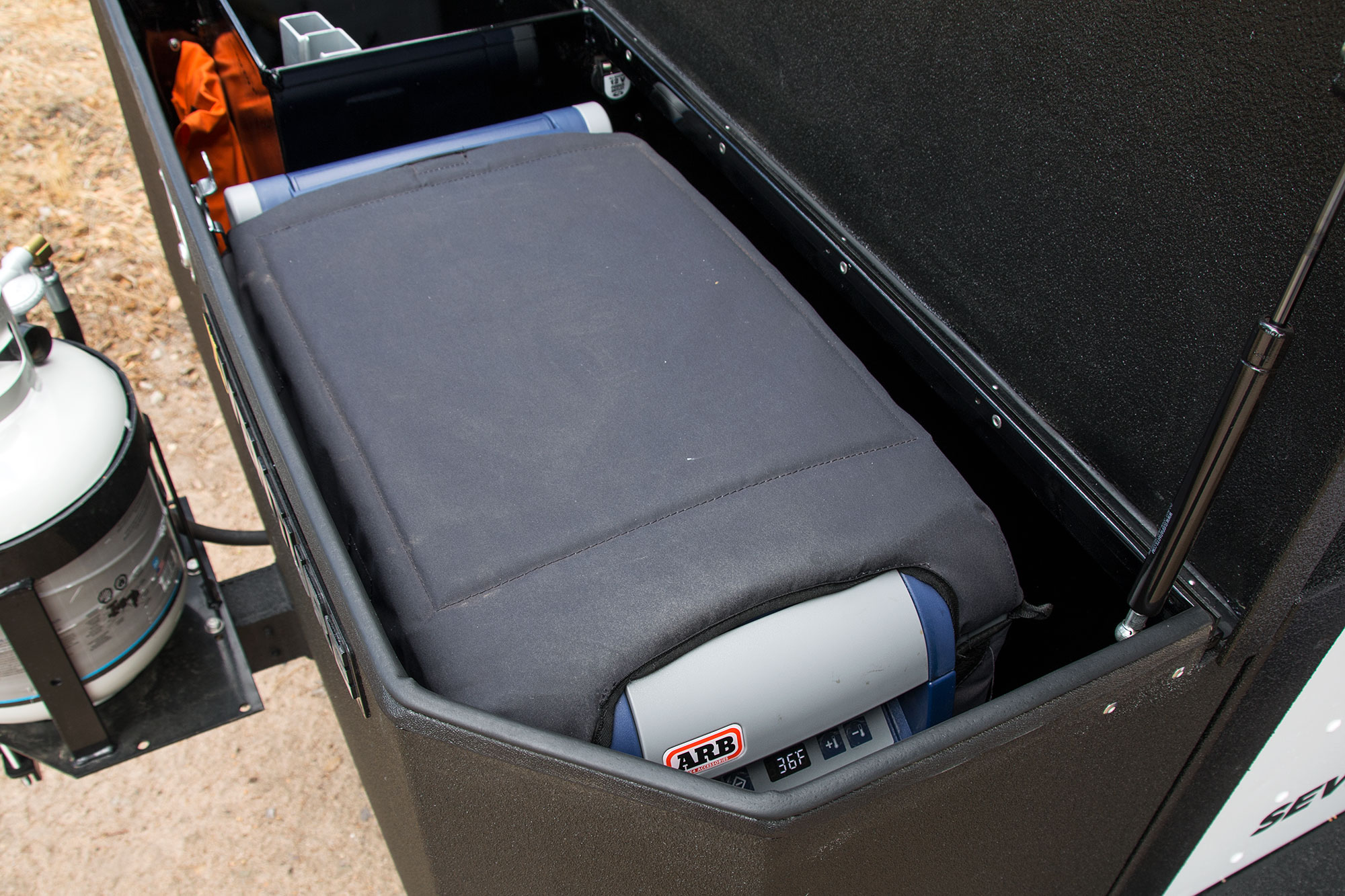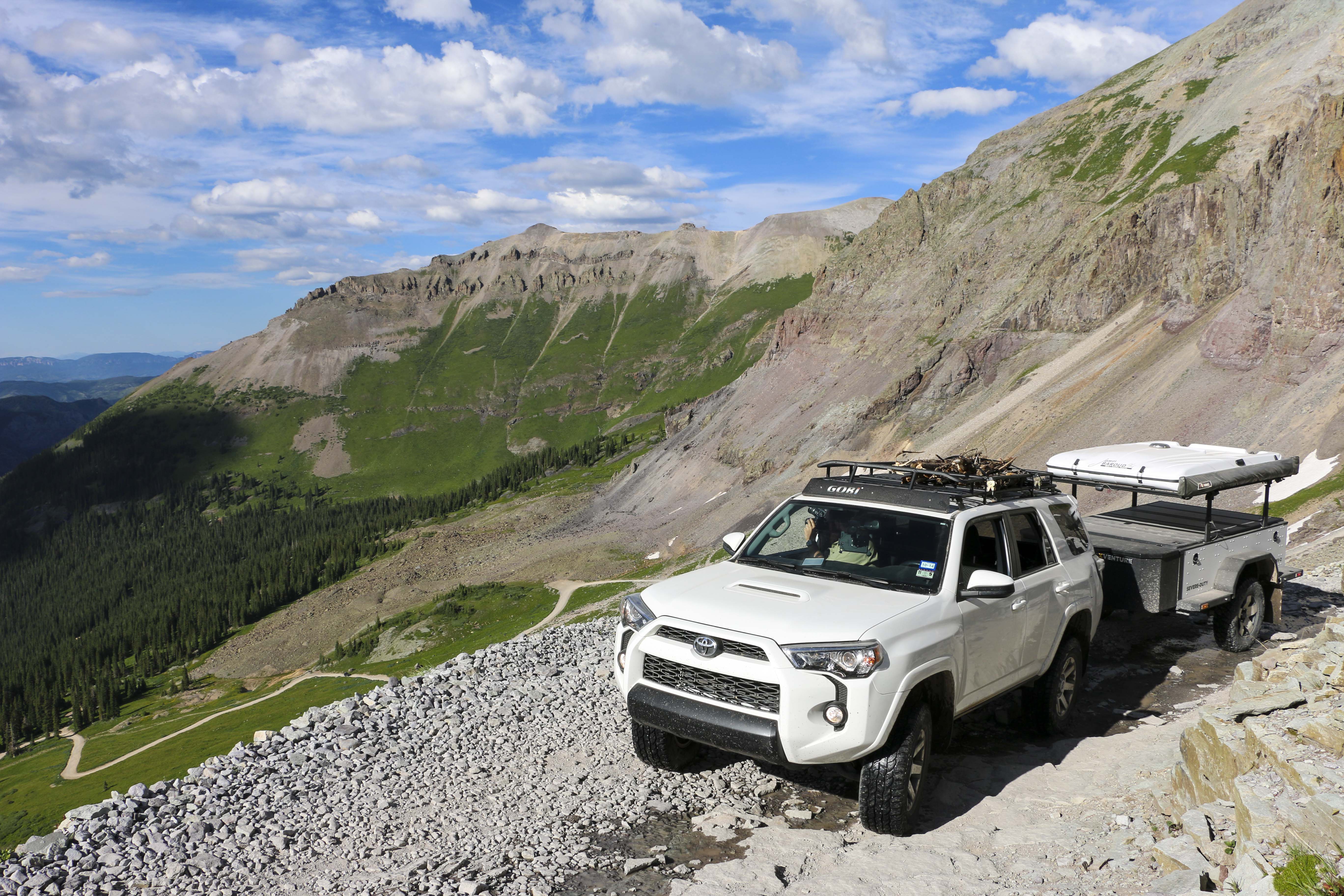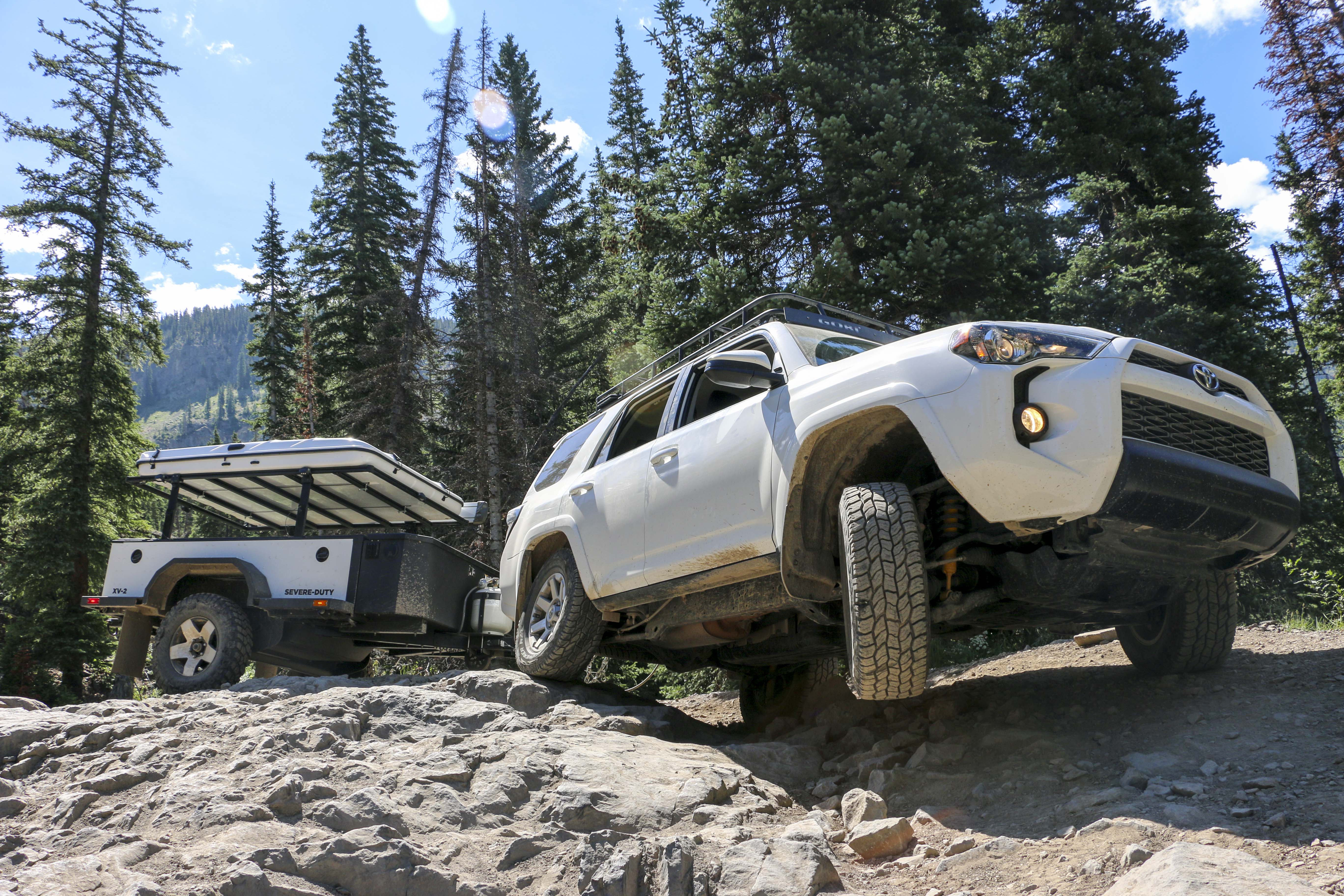“We just passed 11,000 feet,” my passenger said with a smirk. We were heading up Imogene pass, a trail which tops out over 13,000 feet in the mountains of Colorado. A rock-buggy was coming down the easy line on the left, but stopped when he saw us climbing with the trailer in tow. The rest of his group had already lined up behind him making it nearly impossible to back his rig up. Looking to the right, I knew the trailer wouldn’t even flinch at that terrain, it’s what she was made for. I flashed them a quick smile, hit the locker, and let the truck and trailer walk up the hard line without so much as a wheel chirp. The shocked looks and pointing fingers made us grin a little, they were just a few of the many surprised expressions we’d received towing the XV-2.
It has been over a year since we brought this model home to Prescott, Arizona, and the many trips along the way have revealed the good, the bad, and the ugly parts of this mobile base-camp. From suspension to tent lights we’re ready to dive into what it’s like to live with the XV-2 day in and day out, how the systems hold up, and what we think could have been better.
Daily Living
There are many off-road trailers out there which are effectively little more than glorified cargo trailers. The XV-2 is not one of them. From the refrigerator in the front to the hot water heater in the back, it’s designed to be your back country home on wheels. It’s for this reason that we have spent so much time evaluating the effectiveness of every system, and seeing if they work together as seamlessly as they should.
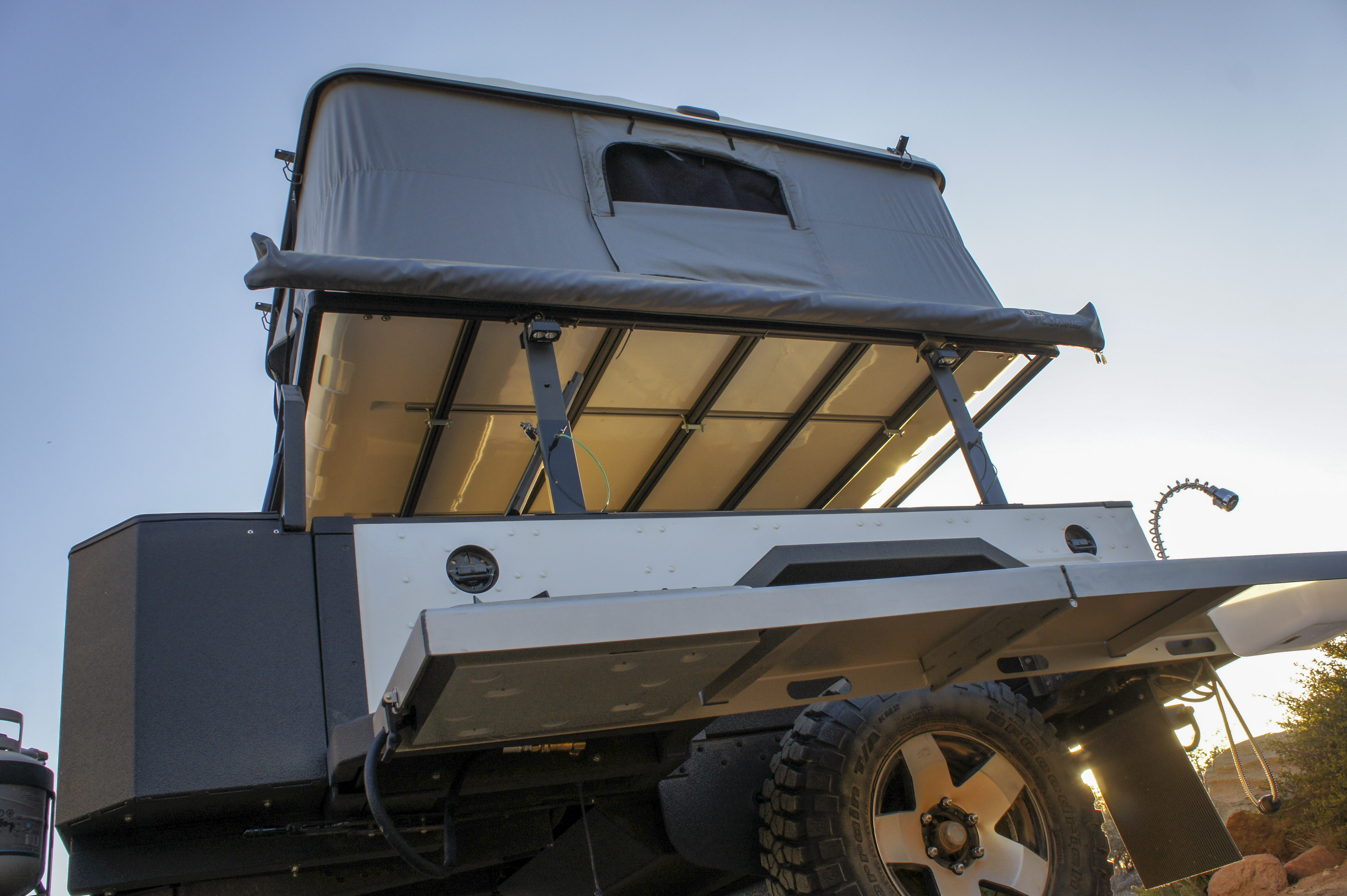

Sleeping
Usually, the first thing people consider when choosing a trailer is the sleeping quarters. The XV-2 comes with a James Baroud roof top tent, perfect for two people to sleep in comfortably with plenty of room to spread out. Over the course of using this trailer, we came to adore this tent as the quick deployment and storage saved significant time and effort each day when compared to a traditional fold out model. Instead of straps and zippers, a quick four latches need to be released and you let the gas struts do the rest.
Besides the easy setup and breakdown, we loved the little things that made living out of this tent even more convenient. For starters, a small solar panel on the roof powers a silent fan which vents, and all but eliminates, condensation on cold nights. Even better, an LED light is mounted toward the front of the tent to make changing, reading, ingress, and egress a simple comfortable task; no more fumbling for a flashlight at 3 AM.
Kitchen & Shower
The kitchen is a big selling point on this trailer, but one we had mixed feeling about. It was one of those things that teetered on the verge of greatness, but somehow just fell short. The concept is fantastic; make a table that slides snugly into the front of the trailer, which can then be pulled out and snapped into place along with a faucet, stove, and sink. It even works as an assembly line from front to back when preparing meals. It’s easy to pull food from the fridge, cook it on the stove, place it to be served, put dishes next to sink, wash them, place dishes at back of trailer to be put away.
The two things holding this setup back were the height, and the stove. As you can see from the images above, the table isn’t exactly towering. It’s a reasonable height for people under six foot, but anyone taller than average needs to be prepared to bend over while cooking. The taller you are, the worse it is.
The problem with the stove was power. We found it to be far too weak for the task at hand, especially if there was any wind in the camp. Food would sit on maximum burn but never really progress to cooking. After several attempts we ended up just taking the hit on number of burners and convenience to bring our Primus instead. Swapping in any stove built for outdoor use would quickly solve the issue.
Those faults aside, the rest of the setup was flawless. The table is excellently crafted and has plenty of space. It includes small details like a stiffener to prevent a slant, and cushioned hand holds to make moving and storing the surface easy and painless. The faucet worked well and the inclusion of hot water via the propane heater absolutely blew us away. When combined with the sink, it allowed us to wash and rinse dishes quickly before passing them off to be dried and placed back inside the trailer. The same hot water system also runs to a shower plug under the opposite fender, which may just be my favorite part of the XV-2. Say what you want, a hot shower in the morning after a few days on the road does wonders.
Tongue Box
The tongue section of the XV-2 is once again so close to perfection, but narrowly misses it with a small oversight. I’ll start by saying that the full-width box concept is awesome. The fact that at 245 pounds I can stand on it to unlatch the tent, take photos, or get a better view without it bending or creaking is an impressive feature in itself. I was very happy with the copious amounts of secure and organized storage it provides for the batteries, fridge, and supplies, and I often found myself using it as a prep surface for food due to its pure convenience.
That being said, I did admittedly find it disappointing that XVENTURE states the middle of the tongue box is designed to hold two Jerry Cans. While this is true, the lack of ventilation in the box means you can’t actually store fuel in the nose, just water. I found it kind of repetitive because there is already a built in water tank below the trailer. While this isn’t really a fault, I feel it would have been better to just label it as storage, since the extra space is far more useful for supplies than big water cans.
Photo by Chazz Layne
The only real problem with the tongue box has to do with the fridge. While we never had an issue with it, the lack of ventilation and space inside the box results in increased power consumption and we assume will eventually on a hot trip, burn out the fridge. When the sun hits the box it heats up, the fridge cools more to compensate which produces heat from its compressor. The heat escapes into the box but has nowhere to go which makes the tongue box warmer. The fridge in turn has to work harder again to keep up so it produces more heat which only makes the box hotter and so on. It’s a vicious cycle. This problem could be largely solved with some proper venting into the center compartment followed by a secondary vent to the outside of the box for cool air.
The rest of the tongue seems to have been well planned and properly setup for long trips. A full sized propane tank is utilized for the hot water heater and stove, which is a good choice for a thirsty system in remote areas. Besides the obvious benefit of carrying more fuel, the 20lb tanks allows for a standard swap out at hardware stores. This may seem rather trivial, but finding a shop that refills small propane tanks is much more difficult than finding one who will simply exchange one.
Another big win was the location of the ARB compressor. Once again it probably doesn’t seem significant, but upon trying to run the hose from my personal compressor at the front of the 4Runner to the trailer, I was startled to find it was too short. Clearly this would be a problem unless I planned to unhook the trailer all the time. The nose-box location of the XV’s compressor however allowed me to not only inflate the trailer’s tires, but the vehicle’s towing it as well.
Accessories and other systems
Hand brakes on trailers rock. I don’t know how every other manufacturer missed the memo, but I have to thank XVENTURE for getting it right. If you’ve moved your trailer alone on any kind of grade, you know the struggle of trying to chock the wheel before it rolls in another direction. With the brakes on all XV models, you can just pull the lever and you’re done and chock the wheels for safety. These are one of the simplest, but most appreciated parts of this trailer.
Photo by Chazz Layne


The fox-wing awning proved to be a crowd favorite when we setup a base-camp for longer stops, especially when we could use it to escape the hot sun or heavy rain. Unfortunately, due to the amount of poles and guide lines required to tighten the awning, we found setup time to be prohibitive on shorter stops. More hands and a little practice could probably make it possible though.
The adjustable rack system is a great selling point, and one that is very unique to this trailer. It enables the user to move the support slats up far enough to fit ATVs or dirt bikes in the trailer, while still deploying the tent above them. Since we rarely needed to haul anything like this, we left the rack in the low position most of the time to optimize aerodynamics for towing and keep CG low for trail use. Our biggest complaint with this system is the clacking sound generated while off-road. Naturally when you have so many moving pieces there is going to be some flex when shaking side to side. Unfortunately, this is amplified by the spaces the slats need to move which makes rough roads a noisy experience.
The final camp feature we’d like to mention is the lighting system used throughout the trailer. Having a lot of illumination on dark nights with the flip of a switch can be extremely helpful. Gone are the days of messing with flashlights, squinting to see if your dishes are clean, and trying to grab the right drink from the table. Turn on the lights and the whole trailer is now in view. We especially appreciated the interior cargo lights. It’s hard enough to dig through the bed and find what you’re looking for in a trailer, doing so in the dark is nearly impossible.
Towing
So we know it’s a great base-camp, but what were our thoughts on long term towing? If you read our mid-term review, you’ll already know that technical trail performance was excellent with phenomenal ground clearance and an easy line of sight. Road towing remained smooth but the 4Runner certainly felt the trailer more than the Range Rover Sport we had tested with previously. It was especially noticeable in Colorado on long grades. The only problem mentioned previously was that any sort of speed on dirt resulted in some unfavorable bouncing and swaying characteristics.
Photo by Chris Ramm
Our long term test conclusion confirmed our initial theory that this trailer’s suspension is made to carry a lot of weight. It makes it perfect for hauling heavy cargo like motorcycles, ATV’s, wood, or large water tanks, but poses a problem for the weekend camping trip. Even with five people’s gear, food, and water, we were barely pushing into the trailer’s hauling capacity. This results in difficulty compressing the XV-2’s heavy duty-axle, as well as a harsh and unstable ride between 5 and 30 miles per hour. Fortunately, these trailers have a range of axle weights available, and we highly recommend the stock 2300lb model if your primary use will be simple camping trips. This should give you a smooth and comfortable ride while saving a few bucks in the process. If you do require the heavier axle, you will need to be sure to load the trailer down properly to attain the desired handling.
Between all the trips completed with this trailer, we backed up at night more times than we can remember. One experience in particular though stands out, backing down a narrow shelf road with no pull outs in the dark. During that situation the reverse lights built into the XV not only helped, but were a major factor in keeping us safe. It’s astonishing how few trailers have lights like this, and how even fewer have the range and dispersal to effectively illuminate the area. We applaud Schutt Industries for going beyond the standard of not only convenience, but safety.
The Verdict
So, a year and many adventures later, what do we think of the XVENTURE?
The bottom line is it’s a brutally tough trailer built to last a lifetime. In every aspect of use the XV-2 makes it clear that at its heart, it is a piece of heavy-duty military equipment. I feel confident every time I hook a Schutt Industries trailer to my vehicle that it will survive water crossings, mud, rocks, and everything we can find to throw at it for years to come. We love the look which is aggressive yet clean, and the wide stance provides more stability than many competitors, while matching the track width of most tow vehicles.
In many ways this product is the tank of the trailer world. It’s the heavy duty, drive over anything, survive whatever you throw at it, rolling hunk of metal you would want in the apocalypse, and it’s not trying to hide that. It will never be the refined and lightweight trailer to go with your Snow Peak kitchen and titanium shovel. It’s heavier, larger, and rides rougher than many of its counterparts; and it’s built to haul serious weight, not a $200 camp chair made of toothpicks and a freeze-dried meal.
At the end of the day, the XV-2 is not for everyone. It’s not the graceful fencer gliding over obstacles with a parry and lunge, but the seven foot tall brute with a club who pounds the rocks into submission.
It may not do its job with the most poise, but it will do it reliably time and time again, and that’s good enough for us.
For more information on the XV-2 and Schutt Industries other offerings, take a look at their website here.


